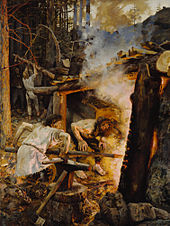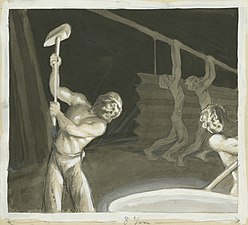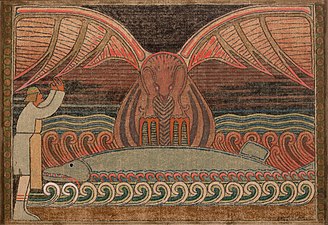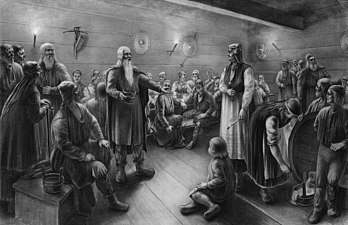Ilmarinen

Ilmarinen (pronounced [ˈilmɑrinen], also known as Ilmari and takoja iänikuinen or "the eternal hammerer"), a blacksmith and inventor in the Kalevala, is a god[1] and archetypal artificer from Finnish mythology. He is immortal and capable of creating practically anything, but is portrayed as being unlucky in love.[2] He is described as working the known metals of the time, including brass, copper, iron, gold, and silver. The great works of Ilmarinen include the crafting of the dome of the sky and the forging of the Sampo. His usual epithet in the Kalevala is seppä or seppo ("smith"),[3] which is the source of the given name Seppo.[4]
Etymology and origin
Cognates of the Finnish word ilma ('air') are attested in almost all the main
Ilmari(nen) is believed to have taken on the qualities of a smith through the Proto-Finnic contact with iron-working cultures, such as the
Ilmarinen is also directly appealed to for aid in several incantation runes.[10] Insofar as Elias Lönnrot heavily redacted the original runes collected by him and others, it's valuable to differentiate between the Kalevala and the original poems sung by rune singers. [11]
Other names for Ilmarinen that are found in rune variants include Ilmorinen and Ilmollini.[12]
Stories about Ilmarinen
The forging of the Sampo

From the Kalevala
- Summary based on Lönnrot 1999, 105-119 [canto 10]
When the old sage, Väinämöinen, was traveling wide in the search of a wife, he was captured by the old mistress of Pohjola, the land of the North. In return for giving him safe passage from the land of Pohjola back to his native country, the enchantress Louhi of Pohjola wanted to have made the Sampo, a magic artifact. Väinämöinen replied that he could not make her one, but that Ilmarinen could, and promised to send the great smith to Pohjola to do just that. In return for this wondrous device, Louhi would also give Ilmarinen her daughter's hand in marriage.
On having returned home, Väinämöinen tries to awe Ilmarinen with tales of the maiden's beauty and so lure him to Pohjola. Ilmarinen sees through the ruse, however, and refuses. Not to be outdone, Väinämöinen tricks the smith into climbing a fir tree trying to bring down moonlight that is glimmering on the branches. Conjuring a storm-wind with his magical song, Väinämöinen then blows Ilmarinen away to Pohjola.
Once there, Ilmarinen is approached by the toothless hag, Louhi, and her daughter, the Maiden of Pohjola, and having seen the maiden's beauty, consents to build a Sampo. For three days, he sought a place to build a great forge. In that forge he placed metals and started working, tending the magic fire with help of the slaves of Pohjola.
On the first day, Ilmarinen looked down into the flames and saw that the metal had taken the form of a crossbow with a golden arch, a copper shaft and quarrel-tips of silver. But the bow had an evil spirit, asking for a new victim each day, and so Ilmarinen broke it and cast the pieces back into the fire.
On the second day, there came a metal ship from the fire, with ribs of gold and copper oars. Though beautiful to behold, it too was evil at heart, being too eager to rush towards battle, and so, Ilmarinen broke the magic boat apart and cast back the pieces once more.
On the third day, a metal
On the fourth day, a golden plow is pulled from the forge, with a golden plowshare, a copper beam and silver handles. But it too is flawed, plowing up planted fields and furrowing meadows. In despair, Ilmarinen destroys his creation once more.
Angered at his lack of success, Ilmarinen conjures the four winds to fan the flames. The winds blow for three days, until finally, the Sampo is born, taking the shape of a magic mill that produces grain, salt and gold. Pleased with his creation at last, Ilmarinen presents it to Louhi, who promptly locks it in a vault deep underground.
Returning triumphant to the Maiden of Pohjola, Ilmarinen bids her to become his wife. To his dismay, she refuses to leave her native land, forcing him to return home alone and dejected.
From original rune variants
Variants of the original runes used by Lönnrot in compiling the Kalevala present a different picture of Ilmarinen. In one variant of The Sampo (Kuusi, Bosley & Branch 1977, rune 12) for example, Ilmarinen goes willingly to Pohjola to forge the Sampo, not because he was tricked by Väinämöinen, but in order to redeem Väinämöinen from death. In addition, the same rune portrays Ilmarinen as returning home successfully with the Maiden of the North.
Ilmarinen's portrayal as "unlucky in love" in the Kalevala is primarily due to Lönnrot's own choices while revising and compiling the original runes to form a cohesive narrative.[n 2] In another example from an original rune entitled Kosinta (The Courtship), (Kuusi, Bosley & Branch 1977, rune 17) Ilmarinen takes a journey to compete for Hiisi's daughter. He again succeeds in obtaining his wife after completing the tasks of ploughing a field of vipers, bringing Tuoni's bear, and bringing the pike of Tuoni.
Ilmarinen's bride of gold
From the Kalevala
- Summary based on Lönnrot 1999, 497-504 [canto 37]
After the loss of his first wife to Kullervo's curse, the disheartened Ilmarinen attempts to craft a new one from gold and silver, but finds the golden wife hard and cold. Dismayed, he attempts to wed her to his brother Väinämöinen instead, but the old sage rejects her, saying that the golden wife ought to be cast back into the furnace and tells Ilmarinen to "forge from her a thousand trinkets". Speaking to all of his people, he further adds:
"Never, youths, however wretched,
Nor in future, upgrown heroes,
Whether you have large possessions,
Or are poor in your possessions,
In the course of all your lifetime,
While the golden moon is shining,
May you woo a golden woman,
Or distress yourselves for silver,
For the gleam of gold is freezing,
Only frost is breathed by silver."[13]
The tale of the Golden Wife can be seen as a cautionary tale based on the theme of "money cannot buy happiness". To a contemporary reader, there is also a similarity to the hubristic nature of the Golem legend, or to Frankenstein, in that even the most skilled of mortals cannot rival divine perfection when creating life.
From original rune variants
In another example of Lönnrot's editorial license, the Kullervo cycle originally existed as an independent series of runes. In his effort to create a homogeneous narrative, Lönnrot presented Kullervo as Ilmarinen's slave in order to insert Kullervo into the Sampo cycle of runes.[14] However, some scholars are convinced that the Golden Bride was originally an independent rune that was eventually added to the Sampo cycle.[15] Furthermore, independent variants of the Kultamorsian (Golden Bride) rune have been collected.[16] In Matti Kuusi's opinion, the warning reproduced above is a secondary element that was probably added during the Christian period. Rather than serving as a cautionary tale, the original runes probably expressed the widespread myth of a Golden Woman found throughout Arctic Eurasia.[17]
In popular culture
- A portrayal of Ilmarinen and depiction of selected tales from the Kalevala can be found in the 1959 movie Sampo (film).
- Finnish metal band Amorphis released their ninth album in 2009 called Skyforger, which is a concept album based around the stories and legends of Ilmarinen.
- The band Turisas recorded a song called "Cursed Be Iron" about the aforementioned smith, and he is mentioned in "Rauta" by Korpiklaani.
- In the trilogy The Winter of the World by duergar, who say he forged the mountains in which they live. Another Power, the Odin-like Raven, speaks of Ilmarinen, "greatest of the Elder Powers," having taught him.[18]
- Ilmarinen appears in Joseph Michael Linsner's comic Dawn: Return of the Goddess when the title character seeks him out to forge a sword for her.
- Ilmarinen appears as Ilmari Heikkinen the Wonder-smith in The Snow Queen(2008).
Gallery
-
Moonwatchers, Joseph Alanen, 1908–1910
-
Väinämöinen and Ilmarinen by the Giant Spruce, Robert Wilhelm Ekman
-
Ilmarinen Flies Over the Moon, Akseli Gallen-Kallela, 1892
-
Ilmarinen Forges the Sampo, Berndt Godenhjelm, 19th century
-
The Forging of the Sampo by Väinö Blomstedt, 1897
-
The Forging of the Sampo, tempera by Joseph Alanen, 1910–1911
-
Illustration of the Sampo being forged, by Rudolf Koivu in 1931
-
Ilmarinen Ploughs a Field of Vipers, Akseli Gallen-Kallela, 1916 (fi)
-
The Eagle and the Pike, Joseph Alanen
-
Ilmarinen Arrives as the Groom at Pohjola, charcoal work by Johan Kortman, 1893
-
The Wedding at Pohjola, Robert Wilhelm Ekman, 1860–1872
-
Pohjolan häät, Johan Kortman, 1890
-
Ilmarinen Forging the Moon, Walter Runeberg, 1866
See also
- Dwarf (mythology), in Germanic myth dwarfs commonly fit the "artificer" archetype
Notes
- ^ (Kuusi, Bosley & Branch 1977) : rune 8 (Seppä, The Smith) explicitly refers to Ilmollini as jumala (god). in Siikala 2002, 171
- ^ Lönnrot's revisions and even rewriting of runes is discussed at length in (Pentikäinen 1999, ch. 2).
References
- ISBN 978-952-222-393-7.
- ^ Lönnrot 1999.
- ^ "seppo". Kielitoimiston sanakirja (in Finnish). Kotimaisten kielten keskus. Retrieved 8 September 2015.[permanent dead link]
- ^ "Kalevala ja suomen kieli". Kalevalan kulttuurihistoria (in Finnish). Kalevalaseura. Archived from the original on 5 March 2016. Retrieved 8 September 2015.
- ^ Frog 2012, pp. 210–11.
- ^ Frog 2012b, p. 25.
- ^ Frog 2012, p. 215.
- ^ Frog 2012b, p. 35.
- ^ Frog 2012, p. 217.
- ^ Siikala 2002, 209.
- ^ Pentikäinen 1999, 19-26.
- ^ Kuusi, Bosley & Branch 1977, runes 8 and 12.
- ^ "The Project Gutenberg eBook of Kalevala, Volume II (of 2), by Anonymous, Translated by W. F. Kirby". www.gutenberg.org. Retrieved 2020-12-02.
- ^ Pentikäinen 1999, 40.
- ^ Pentikäinen 1999, 33.
- ^ Kuusi, Bosley & Branch 1977, runes 21 and 22.
- ^ Kuusi, Bosley & Branch 1977, endnotes for runes 21 and 22..
- ^ Rohan (1988), The Hammer of the Sun, p. 460
Sources
- Kuusi, Matti; Bosley, Keith; Branch, Michael (1977), Finnish Folk Poetry: Epic: An Anthology in Finnish and English, Finnish Literature Society
- Lönnrot, Elias (1999), "The Kalevala", Oxford World's Classics, translated by Bosley, Keith, Oxford University Press
- Pentikäinen, Juha Y. (1999), Kalevala Mythology, translated by Poom, Ritva, Indiana University Press
- Siikala, Anna-Leena (2002), "Mythic Images and Shamanism: A Perspective on Kalevala Poetry", FF Communications (280), Suomalainen Tiedeakatemia
- Frog, Mr; Siikala, Anna-Leena; Stepanova, Eila, eds. (2012), "Mythic Discourses: Studies in Uralic Oral Tradition", S tudia fennica folkloristica, no. 20, Finnish Literature Society
- Frog, Mr (2012), "Confluence, Continuity and Change in the Evolution of Myth: Cultural Activity and the Finno-Karelian Sampo-Cycle", Mythic Discourses: Studies in Uralic Oral Tradition, pp. 205–256
- Hasselblatt, Cornelius; van der Hoeven, Adriaan, eds. (2012b), "Finno-Ugric Folklore, Myth and Cultural Identity : Proceedings of the Fifth International Symposium on Finno-Ugric Languages University of Groningen, 7-9, June 2011", Studia Fenno-Ugrica Groningana, no. 7, ISBN 978-90-423-0415-4
- Frog, Mr (2012b), "Evolution, Revolution and Ethnocultural Substrata: From Finno-Ugric Sky-God to the North Finnic God-Smith Ilmarinen", Finno-Ugric Folklore, Myth and Cultural Identity, pp. 25–43

![Moonwatchers, Joseph Alanen [fi], 1908–1910](http://upload.wikimedia.org/wikipedia/commons/thumb/3/31/Joseph_Alanen_-_Moonwatchers.jpg/169px-Joseph_Alanen_-_Moonwatchers.jpg)



![The Forging of the Sampo by Väinö Blomstedt [fi], 1897](http://upload.wikimedia.org/wikipedia/commons/thumb/4/40/V%C3%A4in%C3%B6_Blomstedt_-_The_Forging_of_the_Sampo.jpg/242px-V%C3%A4in%C3%B6_Blomstedt_-_The_Forging_of_the_Sampo.jpg)




![Ilmarinen Arrives as the Groom at Pohjola, charcoal work by Johan Kortman [fi], 1893](http://upload.wikimedia.org/wikipedia/commons/thumb/a/a0/Johan_Kortman_-_Ilmarinen_Arrives_as_the_Groom_at_Pohjola.jpg/313px-Johan_Kortman_-_Ilmarinen_Arrives_as_the_Groom_at_Pohjola.jpg)


